| Listing 1 - 10 of 10 |
Sort by
|

ISBN: 9056930397 9789056930394 9789004494909 9004494901 Year: 2000 Volume: 20 I Publisher: Groningen : Styx,
Abstract | Keywords | Export | Availability | Bookmark
 Loading...
Loading...Choose an application
- Reference Manager
- EndNote
- RefWorks (Direct export to RefWorks)
The archive of the Egibi family from the 6th century BC originates in Babylon and covers a time span of more than 100 years and five generations. It is known as the largest and most important private archive from the Neo-Babylonian period. Although nearly 800 tablets were already published in cuneiform copies by the end of the 19th century, no comprehensive text edition and study of this archive has been completed so far. This book presents the first step and focuses on the purchase of land (date orchards and arable land) by the Egibi family. About 240 records (property titles and related debt notes, receipts, field plans, etc.) form the core of the archive and are closely interrelated with other aspects of the family's business. Nearly half of them were previously unpublished. The book provides transliterations ans translations of all texts, as well as copies of new material including hitherto unknown sealings of published tablets. The study shows how the Egibi family managed to accumulate considerable wealth in real estate over a relatively short period of time. The impact of inheritance and marriages and the way the estates were damaged are also examined.
Akkadian language --- Cuneiform inscriptions. --- Family archives --- Kleitabletten. --- Spijkerschrift. --- Geschiedbronnen. --- Grondbezit. --- Overeenkomsten. --- Babylonië --- Babylonië. --- Clay tablets --- cuneiform --- History Resources --- Land ownership --- Similarities --- Agrarian tenure --- Feudal tenure --- Freehold --- Land question --- Landownership --- Tenure of land --- Land use, Rural --- Real property --- Land, Nationalization of --- Landowners --- Serfdom --- Archives --- Family records
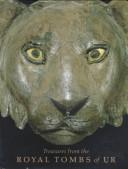
ISBN: 0924171545 0924171553 9780924171543 9780924171550 Year: 1998 Publisher: Philadelphia, PA : University of Pennsylvania Museum of archaeology and anthropology,
Abstract | Keywords | Export | Availability | Bookmark
 Loading...
Loading...Choose an application
- Reference Manager
- EndNote
- RefWorks (Direct export to RefWorks)
This stunning catalogue includes color photographs of more than 230 objects, excavated in the 1930s by renowned British archaeologist Sir Leonard Woolley, from the third-millennium-B.C. Sumerian city of Ur. Learn the fascinating story of the excavation and preservation of these magnificent artifacts.Many of the objects are published in color and fully described for the first time--jewelry of gold and semiprecious stones, engraved seal stones, spectacular gold and lapis lazuli statuettes and musical instruments; and vessels of gold, silver, and alabaster. Curator Richard Zettler sets the stage with a history of Ur in the third millennium and the details of the actual excavations. Art historians Donald Hansen and Holly Pittman discuss the historical importance and significance of the many motifs on the most spectacular finds from the tombs.
Jewelry, Ancient --- Tombs --- Bijoux antiques --- Tombeaux --- Exhibitions --- Expositions --- Ur (Extinct city) --- Ur (Ville ancienne) --- Iraq --- Antiquities --- Archeologie ; steden --- Edelsmeedkunst --- Grafmonumenten ; graftombes --- 7.032(354) --- Kunstgeschiedenis ; Antieke culturen van de Antieke Wereld ; Babylonië --- Ur (Extinct city) - Exhibitions --- Iraq - Antiquities - Exhibitions --- Antiquités sumériennes --- Art sumérien --- Tombes --- Irak --- Our (ville ancienne) --- Catalogues d'exposition
Book
ISBN: 9782859449735 2859449736 9791035104153 Year: 2016 Publisher: Paris : Publications de la Sorbonne,
Abstract | Keywords | Export | Availability | Bookmark
 Loading...
Loading...Choose an application
- Reference Manager
- EndNote
- RefWorks (Direct export to RefWorks)
Ce volume est le fruit d'une réflexion collective des historiens et historiennes de l'université Paris 1 Panthéon-Sorbonne. Il en partage donc les caractères : refus des cloisonnements, choix de la longue durée qui court ici de la Babylonie antique au temps présent, participation de jeunes chercheurs comme d'historiens confirmés. Il interroge l'usage que les historiens font du "mythe" qu'ils considèrent autant sous sa dimension restreinte de "récit fondateur" et transhistorique, que sous son acception plus moderne et sociologique, qui a trait à quelques motifs imaginaires partagés. Il y est donc question d'Amazones et de vampires, de Déluge et de Révolution, de royaumes fabuleux, de sorcières et d'âge d'or de la civilisation. Plus que le rapport entre le vrai et le faux, c'est la rationalité et l'historicité de ces croyances du passé en leur temps que ce livre s'attache à sonder.
Historiography --- Mythology --- History --- Historiography. --- Methodology --- Methodology. --- Légendes et histoire --- Mythe --- Historiographie --- Histoire --- Mythologie --- Congresses. --- Congresses --- Congrès --- Méthodologie --- Congrès --- Méthodologie --- Légendes et histoire. --- Historiographie. --- Histoire. --- Légendes et histoire. --- mythe --- histoire --- historiographie --- légende --- Babylonie antique --- récit fondateur --- vampir --- Déluge --- sorcière --- rationalité --- historicité
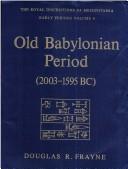
ISBN: 0802058736 9780802058737 9786612039805 1282039806 1442678038 9781442678033 Year: 1990 Publisher: Toronto
Abstract | Keywords | Export | Availability | Bookmark
 Loading...
Loading...Choose an application
- Reference Manager
- EndNote
- RefWorks (Direct export to RefWorks)
This volume covers the Isin-Larsa and Old Babylonian periods, a period marked initially by the struggle of two city-states, Isin and Larsa, for control over the land of Sumer in southern Babylonia. In the end the city-state of Babylon, under its energetic ruler Hammurabi, intervened. At an opportune moment, Hammurabi struck swiftly, defeated Larsa, and incorporated the southern domains into his own realms, thereby creating an empire that for a short time united the lands of Sumer and Akkad.The inscriptions in this volume are grouped by dynasties and arranged in order by ruler within each dynasty. Further, the inscriptions are arranged chronologically within each king's reign. A short introduction for each inscription gives its general contents, place of origin, and relative dating. Also included are a detailed catalogue of exemplars, a brief commentary, bibliography, and text in transliteration facing an English translation. The appended microfiches contain a transliteration of each individual exemplar displayed in a format reminiscent of a musical score.
Akkadian language --- Akkadien (Langue) --- Akkadien (langue) --- Cuneiform inscriptions, Akkadian. --- Cuneiform inscriptions, Sumerian. --- Inschrift. --- Inscripciones cuneiformes. --- Inscriptions cunéiformes akkadiennes. --- Inscriptions cunéiformes sumériennes. --- Quelle. --- Rois et souverains --- Sumerian language --- Sumérien (Langue) --- Sumérien (langue) --- Textes. --- Geschichte 2003 v. Chr.-1595 v. Chr. --- Altbabylonisch. --- Assyria --- Assyrie --- Babylonie --- Babylonien. --- Mesopotamia --- History --- Kings and rulers. --- Histoire --- Sources. --- Historia --- Assur (Kingdom) --- Asshur (Kingdom) --- Akkadian cuneiform inscriptions --- Sumerian cuneiform inscriptions
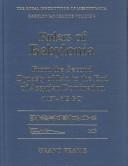
ISBN: 0802007244 1442623748 1442657057 9781442657052 9781442623743 9781442623743 Year: 2002 Volume: 2 Publisher: Toronto University of Toronto
Abstract | Keywords | Export | Availability | Bookmark
 Loading...
Loading...Choose an application
- Reference Manager
- EndNote
- RefWorks (Direct export to RefWorks)
Annotation
Babylone --- -Babylonia --- Vavilonii︠a︡ --- Bavel --- Bābil --- Babylonien --- Cuneiform inscriptions, Akkadian. --- Akkadian language --- Akkadian cuneiform inscriptions --- Babylonia --- Kings and rulers. --- History --- Histoire --- -Cuneiform inscriptions, Akkadian --- Accadian language --- Assyrian language --- Assyro-Babylonian language --- Babylonian language --- Texts --- -Vavilonii︠a︡ --- -Sources --- Kings and rulers --- Cuneiform inscriptions, Akkadian --- Akkadien (Langue) --- Inscriptions cunéiformes akkadiennes --- Textes --- Babylonie --- Sources --- Rois et souverains --- Sumer --- Sources.
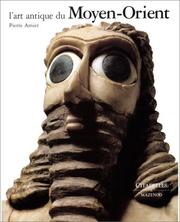
ISBN: 2850880078 9782850880070 Year: 1977 Volume: 7 Publisher: Paris Mazenod
Abstract | Keywords | Export | Availability | Bookmark
 Loading...
Loading...Choose an application
- Reference Manager
- EndNote
- RefWorks (Direct export to RefWorks)
Art, Ancient --- Art --- Archeologie antique --- --Antiquité --- --Proche-Orient --- --Art oriental --- Moyen-orient --- nabije oosten --- Klein-Azië --- Sumer --- Akkad --- Babylonië --- Assyrië --- Anatolië --- Palestina --- Jordanië --- Syrië --- Libanon --- brons --- 7.032.5 --- Antiquity --- Middle East --- kunst --- kunstgeschiedenis --- naslagwerk --- Mesopotamië --- Perzië --- beeldhouwkunst --- architectuur --- keramiek --- kunstnijverheid --- edelsmeedkunst --- 7.03 --- Histoire de l'art --- Antiquité --- Art [Ancient ] --- Antiquities --- Moyen-Orient --- 700 --- Proche-Orient --- kunst algemeen --- art généralités --- Art oriental --- Art, Ancient - Middle East --- Art - Middle East --- Art antique
Book
ISBN: 1283120070 9786613120076 9004189645 9789004189645 9789004189638 9004189637 9781283120074 6613120073 Year: 2011 Publisher: Leiden Brill
Abstract | Keywords | Export | Availability | Bookmark
 Loading...
Loading...Choose an application
- Reference Manager
- EndNote
- RefWorks (Direct export to RefWorks)
Sons and Descendants represents the first comprehensive study of Babylonian family names. Drawing primarily on evidence from legal documents from the early Neo-Babylonian period (747-626 B.C.), the book examines the presence of large, named kin groups at the major Babylonia cities, considering their origins and the important roles their members played as local elites in city governance and temple administration. The period of Neo-Assyrian ascendance over Babylonia marks the first for which there is adequate textual material to allow for a study of these groups, but their continued presence and prominence in Babylonia under the native Neo-Babylonian dynasty and the Persian Empire means that this work is an important contribution to Assyriological understanding of Neo-Babylonian society.
Elite (Social sciences) --- Kinship --- Names, Personal --- Elites (Social sciences) --- Leadership --- Power (Social sciences) --- Social classes --- Social groups --- Anthroponomy --- Baby names --- Christian names --- Family names --- Forenames --- Names of families --- Names of persons --- Personal names --- Surnames --- Names --- Onomastics --- Ethnology --- Clans --- Consanguinity --- Families --- Kin recognition --- Social aspects --- Babylonia --- Vavilonii︠a︡ --- Bavel --- Bābil --- Babylonien --- Sumer --- Social conditions. --- Parenté --- Noms de personnes --- Élite (sciences sociales) --- Aspect social --- Babylonie --- Conditions sociales. --- Parenté --- Élite (sciences sociales)
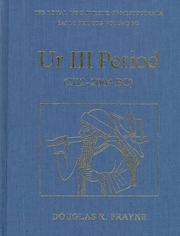
ISBN: 0802041981 1442623764 1442657065 9781442657069 9780802041982 Year: 1997 Volume: v. 3/2 Publisher: Toronto University of Toronto press
Abstract | Keywords | Export | Availability | Bookmark
 Loading...
Loading...Choose an application
- Reference Manager
- EndNote
- RefWorks (Direct export to RefWorks)
This volume provides editions of all known royal inscriptions of the five kings of the Third Dynasty of Ur (2112-2004 BC), from Ur-Nammu to Ibbi-Sin, as well as those of contemporaneous rulers of states on the periphery of the Ur III empire (excluding Elam). Ur III Period contains the first complete edition of the Fu-Sin inscriptions, the most complete and up-to-date information on the members of the Ur III royal family, and the first published charts of Ur III city governors, providing a wealth of new material for researchers.Douglas Frayne has provided indexes of museum numbers, excavation numbers, provenances, dimensions, and lines preserved of the various exemplars in an easy-to-read tabular mode. The accompanying microfiche, now incorporated at the back of the book, displays the text of selected inscriptions in a "musical score" format. Most of the inscriptions are in Sumerian, with a few in Akkadian and one in Hurrian.Ur III Period (2112-2004 BC) is yet another exhaustively researched and substantial contribution to the RIM project, and to the study of ancient Mesopotamia.
Cuneiform inscriptions, Sumerian. --- Cuneiform inscriptions, Akkadian. --- Sumerian language --- Akkadian language --- Inscriptions cunéiformes sumériennes --- Inscriptions cunéiformes akkadiennes --- Sumérien (Langue) --- Akkadien (Langue) --- Texts --- Textes --- Ur (Extinct city) --- Babylonia --- Our (Ville ancienne) --- Babylone --- Babylonie --- Ur (Ville ancienne) --- Kings and rulers. --- History --- Sources. --- Histoire --- Sources --- Rois et souverains --- Cuneiform inscriptions, Akkadian --- Cuneiform inscriptions, Sumerian --- Sumerian cuneiform inscriptions --- Akkadian cuneiform inscriptions --- -Babylonia --- -Ur (Extinct city) --- -Iraq --- Muqayyar, Tall al- (Iraq) --- Tall al-Muqayyar (Iraq) --- Tell el-Mukayyar (Iraq) --- Tell el-Muqayyar (Iraq) --- Ur (Ancient city) --- Ur of the Chaldees (Extinct city) --- Urim (Extinct city) --- Iraq --- -Sources --- Kings and rulers --- Antiquities. --- Antiquities --- Inscriptions cunéiformes akkadiennes. --- Inscriptions cunéiformes sumériennes. --- Textes. --- Inscriptions cunéiformes sumériennes. --- Inscriptions cunéiformes akkadiennes. --- Sumérien (Langue) --- Our (Ville anciene) --- Rois et souverains. --- Inscriptions cunéiformes sumériennes --- Inscriptions cunéiformes akkadiennes --- Vavilonii︠a︡ --- Bavel --- Bābil --- Babylonien --- Sumer

ISBN: 1281384259 9786611384258 9047404181 9789047404187 9781281384256 9004124012 9789004124011 6611384251 Year: 2007 Publisher: Leiden Boston Brill
Abstract | Keywords | Export | Availability | Bookmark
 Loading...
Loading...Choose an application
- Reference Manager
- EndNote
- RefWorks (Direct export to RefWorks)
This collection of articles is the first collection of studies on the specific subject of disease in Babylonia, based upon actual medical texts, with contributions by senior scholars who have spent years working on published and unpublished cuneiform medical texts. The volume contains editions of unpublished materials as well as syntheses of information about specific diseases in Babylonia, such as fever, published here for the first time. The volume will be important for anyone interested in the history of ancient medicine as well as being an important contribution to Assyriology.
History, Ancient --- Bijgeloof. --- Oudheid. --- Ziekten. --- Health Knowledge, Attitudes, Practice --- History of Medicine --- Medicine, Traditional --- Superstitions --- Medicine, Assyro-Babylonian. --- Assyro-Babylonian medicine --- Medicine, Ancient --- Medicine, Oriental --- Superstition --- Spirit Possession --- Indigenous Medicine --- Primitive Medicine --- Traditional Medicine --- Ethnomedicine --- Folk Medicine --- Folk Remedies --- Home Remedies --- Medicine, Folk --- Medicine, Indigenous --- Medicine, Primitive --- Folk Remedy --- Home Remedy --- Remedies, Folk --- Remedies, Home --- Remedy, Folk --- Remedy, Home --- Traditional Pulse Diagnosis --- Materia Medica --- Nostrums --- Pharmacognosy --- Plants, Medicinal --- Ethnopharmacology --- Medicine, History --- History Medicines --- Medicine Histories --- Medicines, History --- Medicine --- Knowledge, Attitudes, Practice --- Ancient History (Medicine) --- Ancient History of Medicine --- History of Medicine, Ancient --- Medicine, Ancient History --- Ancient History --- Ancient Histories (Medicine) --- Ancient History Medicine --- Ancient History Medicines --- Histories, Ancient (Medicine) --- History Medicine, Ancient --- History Medicines, Ancient --- History, Ancient (Medicine) --- Medicine Ancient History --- Medicines, Ancient History --- history --- Babylonië. --- Médecine assyro-babylonienne --- History
Periodical

ISSN: 20768435 00397946 07682506 Year: 1920 Publisher: Paris : Librairie Paul Geuthner,
Abstract | Keywords | Export | Availability | Bookmark
 Loading...
Loading...Choose an application
- Reference Manager
- EndNote
- RefWorks (Direct export to RefWorks)
Depuis 1920, la revue Syria. Archéologie, art et histoire est publiée par l’Institut français du Proche-Orient (Ifpo) avec le concours du CNRS. La revue se consacre à l’histoire ancienne et à l’archéologie du Proche-Orient, Chypre compris. De la préhistoire au viie siècle et de la Méditerranée au plateau iranien, Syria traite d’archéologie, d’épigraphie, de philologie, d’histoire et d’histoire de l’art.
Art
---
Archaeology
---
Art, Asian
---
Antiquities.
---
Archaeology.
---
Art.
---
Art, Asian.
---
Syria
---
Middle East.
---
Syria.
---
Antiquities
---
Art, Occidental
---
Art, Visual
---
Art, Western (Western countries)
---
Arts, Fine
---
Arts, Visual
---
Fine arts
---
Iconography
---
Occidental art
---
Visual arts
---
Western art (Western countries)
---
Art, Daghestan
---
Archeology
---
Archaeological specimens
---
Artefacts (Antiquities)
---
Artifacts (Antiquities)
---
Specimens, Archaeological
---
Art, Asiatic
---
Art, Oriental
---
Asiatic art
---
Oriental art
---
Sirii︠a︡
---
Iqlīm al-Sūrī (United Arab Republic)
---
Iqlīm al-Shamālī (United Arab Republic)
---
Syrian Region (United Arab Republic)
---
سوريا
---
Sūriyā
---
Jumhūrīyah al-ʻArabīyah al-Sūrīyah
---
Syrian Arab Republic
---
République arabe syrienne
---
Sowria
---
Syrie
---
R.A.S.
---
RAS
---
Ittiḥād al-Duwal al-Sūrīyah
---
Fédération des États de Syrie
---
Syrische Arabische Republik
---
SAR
---
Suryah
---
Arabska Republika Syryjska
---
Syrien
---
Jumhuriya al-Arabya as-Suriya
---
Repubblica Araba Siriana
---
جمهورية العربية السورية
---
Jumhūriyyah al-ʻArabiyyah as-Sūriyyah
---
Сірыя
---
Siryi︠a︡
---
Сірыйская Арабская Рэспубліка
---
Siryĭskai︠a︡ Arabskai︠a︡ Rėspublika
---
Сирийската арабска република
---
Siriĭskata arabska republika
---
Συρία
---
Αραβική Δημοκρατία της Συρίας
---
Aravikē Dēmokratia tēs Syrias
---
시리아
---
Siria
---
סוריה
---
רפובליקה הערבית הסורית
---
Republiḳah ha-ʻArvit ha-Surit
---
シリア
---
Shiria
---
Сирия
---
Сирийская Арабская Республика
---
Siriĭskai︠a︡ Arabskai︠a︡ Respublika
---
Сирія
---
Syrii︠a︡
---
Сирійська Арабська республіка
---
Syriĭsʹka Arabsʹka respublika
---
敘利亞
---
Xuliya
---
United Arab Republic
---
Asia, Southwest
---
Asia, Western
---
Eastern Mediterranean
---
Fertile Crescent
---
Levant
---
Mediterranean Region, Eastern
---
Middle East
---
Mideast
---
Near East
---
South West
---
Southwest Asia
---
Arts
---
Aesthetics
---
Anthropology
---
Auxiliary sciences of history
---
Material culture
---
History
---
Asia
---
Sūriy
---
Sirii͡
---
Siriĭskai͡a Arabskai͡a Respublika
---
Siryi͡
---
Siryĭskai͡a Arabskai͡a Rėspublika
---
Syrii͡
---
Art syrien
---
Archéologie
---
Art moyen-oriental
---
Antiquités
---
Asia, West
---
West Asia
---
Western Asia
---
Eastern Mediterranean Region
---
E-journals
---
281.81
---
281.83
---
939.4
---
902 <394>
---
7.032.5
---
#BIBC:tijdschradm
| Listing 1 - 10 of 10 |
Sort by
|

 Search
Search Feedback
Feedback About UniCat
About UniCat  Help
Help News
News